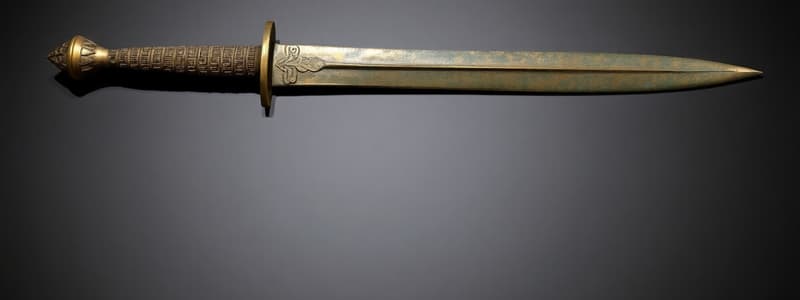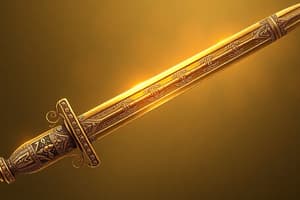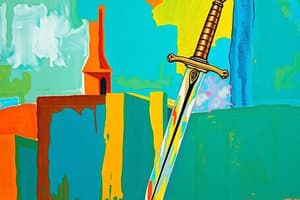Podcast
Questions and Answers
What conclusion can be reliably drawn from the discovery of a bronze sword bearing the insignia of Ramses II within a military fort?
What conclusion can be reliably drawn from the discovery of a bronze sword bearing the insignia of Ramses II within a military fort?
- The sword was mass-produced and distributed to all soldiers stationed at Tell Al-Abqain.
- Ramses II personally led military campaigns in the area where the sword was found.
- A high-ranking military official, connected to Ramses II, likely possessed the sword. (correct)
- The sword was likely a ceremonial piece used in religious rituals dedicated to Ramses II.
Considering the age and context of the bronze sword's discovery, what primary analytical technique would be most useful in determining its precise origin and composition?
Considering the age and context of the bronze sword's discovery, what primary analytical technique would be most useful in determining its precise origin and composition?
- Linguistic analysis of the markings to determine the language of the sword's creators.
- Carbon-14 dating to determine the exact age of the bronze material.
- X-ray fluorescence (XRF) to analyze the elemental composition of the metal. (correct)
- Stratigraphic analysis of the surrounding soil layers to pinpoint the burial date.
Given that the sword was discovered in mud barracks, what does this suggest about the environmental conditions and their effect on the sword's preservation?
Given that the sword was discovered in mud barracks, what does this suggest about the environmental conditions and their effect on the sword's preservation?
- The mud provided a hermetic seal, preventing any oxidation and preserving the sword's shine.
- The mud offered a stable, low-oxygen environment that slowed corrosion, helping to maintain the sword's condition. (correct)
- The mud composition created a unique environment that rapidly degraded the bronze, resulting in its discovery as fragments.
- The mud's alkaline properties neutralized any acids, which prolonged the sword's lifespan.
How does the discovery of the Ramses II-era sword at Tell Al-Abqain contribute to our understanding of ancient Egyptian military strategy and logistics?
How does the discovery of the Ramses II-era sword at Tell Al-Abqain contribute to our understanding of ancient Egyptian military strategy and logistics?
If similar artifacts were discovered in other military forts along the same trade route, what might this suggest about the distribution of power and influence during Ramses II's reign?
If similar artifacts were discovered in other military forts along the same trade route, what might this suggest about the distribution of power and influence during Ramses II's reign?
If a similar sword, but with a different king's name, were found at another fort from a later period, what could that suggest?
If a similar sword, but with a different king's name, were found at another fort from a later period, what could that suggest?
How would the discovery of a large number of unfinished swords at the fort change Peter Brand's initial interpretation?
How would the discovery of a large number of unfinished swords at the fort change Peter Brand's initial interpretation?
If archaeologists were to analyze the fish bones found in the clay pots and determine that they were imported from a distant region, what would this suggest about the fort's inhabitants?
If archaeologists were to analyze the fish bones found in the clay pots and determine that they were imported from a distant region, what would this suggest about the fort's inhabitants?
How does the discovery of both grain storage and ovens within the fort contribute to understanding the fort's role in Ramses II's military and economic strategies?
How does the discovery of both grain storage and ovens within the fort contribute to understanding the fort's role in Ramses II's military and economic strategies?
What conclusion can be drawn from the juxtaposition of utilitarian items (grain storage, ovens) and status symbols (sword, bead necklaces) found at the fort?
What conclusion can be drawn from the juxtaposition of utilitarian items (grain storage, ovens) and status symbols (sword, bead necklaces) found at the fort?
Flashcards
Ancient Egyptian sword
Ancient Egyptian sword
A sword found at a fort, indicating defense and possibly royal status.
Kohl
Kohl
A dark powder used by ancient Egyptians for eye protection against the sun.
Ramses II
Ramses II
Famous pharaoh known for military success and monumental architecture.
Grain storerooms
Grain storerooms
Signup and view all the flashcards
Artifacts from fort
Artifacts from fort
Signup and view all the flashcards
Bronze Sword
Bronze Sword
Signup and view all the flashcards
Tell Al-Abqain
Tell Al-Abqain
Signup and view all the flashcards
Military Official
Military Official
Signup and view all the flashcards
Archaeological Discovery
Archaeological Discovery
Signup and view all the flashcards





